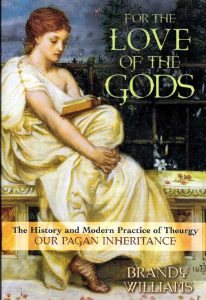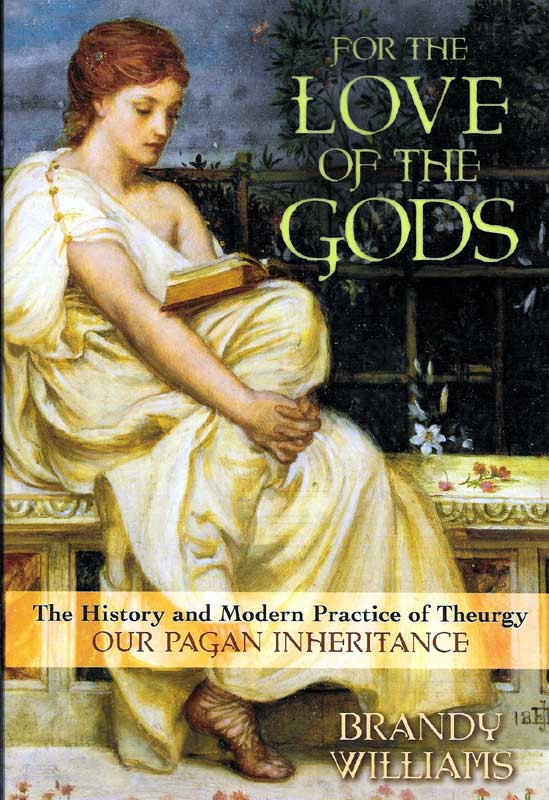
For the Love of the Gods: The History and Modern Practice of Theurgy is both an historical narrative of the ancient traditions of pagan religion and modern spiritual practices. It traces is roots from the Kemet school of divinity in Egypt to the neo-platonists of the 17th and 19th Centuries and onwards. In this review we take a deep look at the spiritual discipline offered as the foundation of spiritual practice and theurgy, and look to the powerful effect of the storytelling technique of presenting the Ancestor/Teachers of this sacred tradition, thought to be lost.
In these days of religious tolerance and interfaith dialogue – along with Wiccans and Pagans participating in the Parliament of the World’s Religions – if any belief or faith community were to enact polemical practices against the so-called ‘Pagans’ and attempt to eradicate Pagan Theurgy, there would be a hue and cry, and matters would be very sharply brought to a halt. The Universal Declaration of Human Rights would be invoked and those engage in plunder, pillage and destruction of a spiritual tradition would be put before the courts to earn the consequences of their contempt.
Theurgy is a Pagan religious and magical practice that was passed from teacher to student. Although some have declared the the connection to the Pagan past was destroyed, this book links contemporary rituals with ancient teachers, carefully reclaiming Pagan theurgic practice in the context of history. Divided into two parts, this presents “Stories from the Ancestors” and “The Living Tradition”. It is this second part which provides both an ancient and modern practice for engaging in the spiritual realm that is worthy of examination and practice.
The majority of chapters engage in spiritual or theurgic practice. There is a narration of how novices or acolytes along with the priestesses and other votaries enter the spiritual realm and take up their sacred duties. The common narration has three elements: settle the body, still the mind, contemplate the divine. These steps are both appropriate and relevant for many spiritual practices today. We say spiritual here for spirituality is not prescriptive – nor is it restrictive. Religious practices specify a path to the Divine and how one merits a reward (and punishment for failures and deviations from that path). Spiritual practices are simply that which work for the aspirant; at its most simple, it is like opening a window to the divine; whatever works for the aspirant is their most appropriate window to the divine.
Settle the Body
Settle the body is a common doorway to spiritual practice. It is a form of shaping the mind, training the mind to accept a discipline and to follow a path: when the mind receives these signals, it begins to slow down and prepare. Settle the body may take any form: going to a favoured place of contemplation and meditation; sitting in a certain pose, slowing the breath, concentrating on the tip of the nose. It may involve tensing and relaxing all the muscles of the body in sequence; it may involve slow, deep breathing, or it may simply observe the breath entering and leaving the body. All these practices settle the body and prepare the mind for what is to follow.
Settle the body does not mean one devalues the body. We know St Francis called his body “Brother Ass” and used it simply as a vehicle to move from one place to another and frequently observed his body as an obstacle to contemplating his Loving Lord. While some spiritual traditions abhor or practice abnegation of the physical body, we should keep in mind that we are spiritual beings (i.e., we have a spirit within, the SOUL) having a human experience and hence we should respect the body and treat it with care. Others insist spiritual aspirants ought be vegetarians and that meat eating is an obstacle to spiritual progress. For some, it may well be. For others, where physical strength is needed, meat eating is needed for energy. Others still need iron in one form or another in their diet or they become anaemic and weak. There is no hard and fast rule in spirituality about meat eating, what is offered, is that if one wishes to follow the spiritual path, it is better to refrain from eating of meat. Ditto alcohol, ditto smoking, all of which affect the mind-body-spirit complex. It is much easier to settle the body when we are not craving for a cigarette or a drink, and we can settle down to a state of rest, undisturbed. This brings us to our next pane in the window to the divine, still the mind.
Still the Mind
Wayward and unsteady minds often bring a person to grief. They achieve none of their personal goals and make no progress on the path of life. To be able to manage one’s mind and direct it along a certain path is a precious gift. The mind is like a cart; with no bullocks to pull it, it can go nowhere. Put a pair of bullocks in the stirrups and direct them by means of a switch and reins, the cart and proceed and take its load toward the desired destination. So too, mind management enables the aspirant to reach their personal destination. A mind full of chatter and distractions will not enable spiritual productivity nor progress. A specific task of contemplation with unswerving endeavour is needed. We prepare with ‘settle the body‘; the mind gets its preliminary signals that an inner discipline is about to be followed. With still the mind, we engage in the same method each time to take the mind to steadiness and silence.
Every one is able to gain success in their profession or occupation only through concentration and one-pointedness in effort. Even the smallest of tasks needs for its fulfilment the quality of concentration. It is concentration which brings success to any activity we take up. The mind flies at a tangent all the time. Single-pointedness is the process by which it is trained to acquire concentration. which we may call single-pointed meditation. For the person engaged in research in a laboratory, for one walking along a road, or for a scholar reading a book, or an individual writing a letter, or driving a car, the concentration of all their attention on the articles before them and the activity they are engaged in is very important. He or she understands the nature and peculiarities of the object he is handling. The more intense your concentration, the more successful will be your activity. When the mental abilities are focussed on one effort, knowledge can be acquired quicker and from a wider field. And, that is the only way by which knowledge can be earned.
Concentration will enable one, whoever he is, whatever the activity he is engaged in, to finish it much better than otherwise. Whether in material assignments, or in ordinary day-to-day work or in spiritual pursuits, concentration of mental energies is a must, if success is to be achieved. It is the key that can open the treasure-chest of awareness and wisdom. Millions of unwelcome, unwanted, unnecessary and even harmful thoughts enter our minds and confound their activities. These have to be kept out; the mind has to be guarded and controlled and kept under our rigorous supervision. Hence, steadiness, concentration, single-pointed meditation.
Contemplate the Divine
Contemplating the Divine means keeping the mind away from the world, withdrawing all contact with the sensory world.In this state of Disinterestedness we have created an inner space for contemplation. To contemplate means to think deeply about a subject. As we study the teachings of our spiritual teachers – or in this book, the Ancestors – we may find some ideas that are easy to understand, make sense to us and lead us on to peace. Other ideas may be new or contradict our thoughts, challenging our world-view. We may find that the new idea reshapes the way we understand the world.
It is said that the mind is made up of many thoughts (sometimes it is called a bundle of thoughts). It is also made up of subtle instruments, the intellect, the discrimination and the faculty of detachment. It is discrimination and detachment which enables contemplation of the divine.
There is a clear distinction between simple theosophical study and contemplation of the divine and – as per the subject of this book, theurgy and theurgic contemplation. It is the grounding and creation of a sacred environment for the mind-body-spirit complex that these steps of settle the body, still the mind, contemplate the divine provide. Moreover, rituals provide sacred grounding, where we may light candle and incense, chant prayers and mantras, supplicate the divine with oration and offering, and repose ourselves in a sacred environment – whether is this in a public sacred space such as a temple, grotto or chapel, or be it a sacred space we have created for ourselves with shrine, flowers, candles, images of the divine we worship. Ritual and sacred space build the environment for contemplation of the Divine to take place.
The Ancestors
In contemporary life, the word “ancestors” often means the people connected to our bodies – that is, our mothers, and fathers and their mothers and fathers as far back as we can reach. Another way to look at ancestors is to look to the ancestors of our souls, a family of spirit. Any ancestor who speaks to us can form part of that lineage. It does not need to be part of a blood-relationship. Pagan theology has a category of people who stand out above the rest, who contribute so much and live such exemplary lives that they occupy a space between humans and spirits. The term for these people is ‘heroes’ and especially, ‘teachers’.
To ancient Pagans, teachers were not simply people who imparted knowledge. They were also spiritual guides. They themselves glowed with the energy of the gods they invoked, serving as intermediaries between the students and the gods. They inspired respect but also reverence and love. Individually, they can guide us; collectively they form the golden chain connecting us to our human past and the knowledge of the ultimate source of our souls.

trees are known to be home to spirits and often, more than one. Here, a tree is home to three Mother Goddess forms.
It is thought that the Pagan tradition had been suppressed by various authorities over time and that these forms of worship had been consigned to history. Not so, using storytelling as a vehicle, the author Brandy Williams brings a rich narrative to life and gives examples of how settle the body, still the mind, contemplate the divine was practised in many different times and places. The worship of many gods is fairly common in Pagan communities and is widely considered a sort of reclaiming of past traditions. For the Love of the Gods by Brandy Williams dives into the rich history of theurgy and pulls apart the lessons we can learn from the past, above and beyond feast days and offerings. Theurgy as defined in this book is the “gods’ work,” which can mean the work that we do for and with the gods, or the work the gods do for us.
Commencing with the Kemet tradition, the book traces a path of sacred teaching and practices from Plato through Plotinus, Sosipatra, Proklos and Asklepignia through studying at the Academy, Jewish and Neo Platonists in Spain through Platonists in the Seventeenth and Nineteenth centuries. Much history is covered, and through story telling, students and teachers are brought to life and the possibilities of spiritual advance, progress and penetration into the mysteries are uncovered.
In “Lessons from the Teachers” we learn that theurgy is a literate tradition, rooted in Kemet (where the storytelling commences) and owes a debt to India. We can only speculate on the nature of this debt, whether it is the replication of the sound that reproduces the pranava, whether it is the 21 syllable mantra or if it is the technique of consecrating candle, flame, light. Plato is given the strong shoulders upon which the tradition of theurgy rests upon; it is very clearly an urban tradition and not of the desert anchorites nor those up in their stylite towers. Theurgy is presented as a religious tradition with disciplines, teachings, scriptures and methods of research not unlike those of biblical research such as form criticism, tradition criticism, redaction criticism, sitz-im-leben and the like. Much research and study is done, and the book has plentiful resources on each Ancestor/Teacher presented.
One final reflection is necessary. This book begins with the roles and functions of women in the traditions of Kemet (Egypt). We do know that Pharaoh’s destroyed sacred traditions. Christianity was to do the same later. However, in the process, much antipathy, aversion and distaste about the role of women in religion and theurgy was to unfold. Women were often removed from the sacred records, whether this was racism or discrimination, we do not know. But they were removed. Brandy Williams has clearly restored their rightful roles beginning with their place as votaries, functionaries and servants of the gods in Kemet. The racist and sexist biases of early academics and clergy are being uncovered and redacted, and there is so much history that is only now being rediscovered.
For the Love of the Gods, The History and Practice of Modern Theurgy
Paperback: 360 pages
Publisher: Llewellyn Publications (September 8, 2016)
Language: English
ISBN-10: 0738744697
ISBN-13: 978-0738744698
Product Dimensions: 6 x 1 x 8.9 inches
Shipping Weight: 1 pounds

